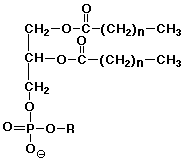

Quiz, Chapter 16 - Answer Key
1. (4 points) Depending on the group attached at the phosphate ester
position, a phospholipid could be either negatively charged or a zwitterion
(neutral). Give an example of each type. Be as specific as you can with
all of the aspects of the structures (more specific = more points).

The fatty acid components involve an even number of carbon atoms, typically
C10 to C20, and may have one or more cis double bonds.
The R group may be a variety of structures.
If R is neutral, the overall phospholipid will have a net negative charge,
e.g, phosphatidylserine.

If R is positively charged, the overall phospholipid will be neutral,
e.g, phosphatidylcholine or lecithin.

2. (3 points) Nitrous acid was used earlier to make diazonium ions
from aminoaromatic compounds. In the case of some of the nucleic acid bases,
nitrous acid reaction with amino groups could lead to mutagenic activity.
Examine its reaction with cytidine (shown below, where R represents ribose).
Explain why this could lead to a mutation. Be specific by considering what
would happen to the sequence CAU if the indicated reaction took place and
what error in translation would occur.

The above reaction converts C into U.
Thus the codon CAU would become UAU .
CAU translates as His, but UAU translates as Tyr.
This is a mutation, and the single amino acid difference could have
a significant effect on the functioning of the ultimate polypeptide.
3. (3 points) Explain the terms replication, transcription, and translation
as applied to nucleic acids. (Use the back of this sheet)
Replication: creation of identical copies of double-stranded DNA by unwinding
and generating new complementary strands for each of teh original strands
Transcription: reading of information from DNA by unwinding and creating
a messenger RNA strand from one of the original DNA strands
Translation: conversion of the message in m-RNA into a polypeptide by
reading 3-base codons and utilizing transfer-RNAs to match the codons (with
anticodons) while bringing in the appropriate amino acids
![]()
![]()


